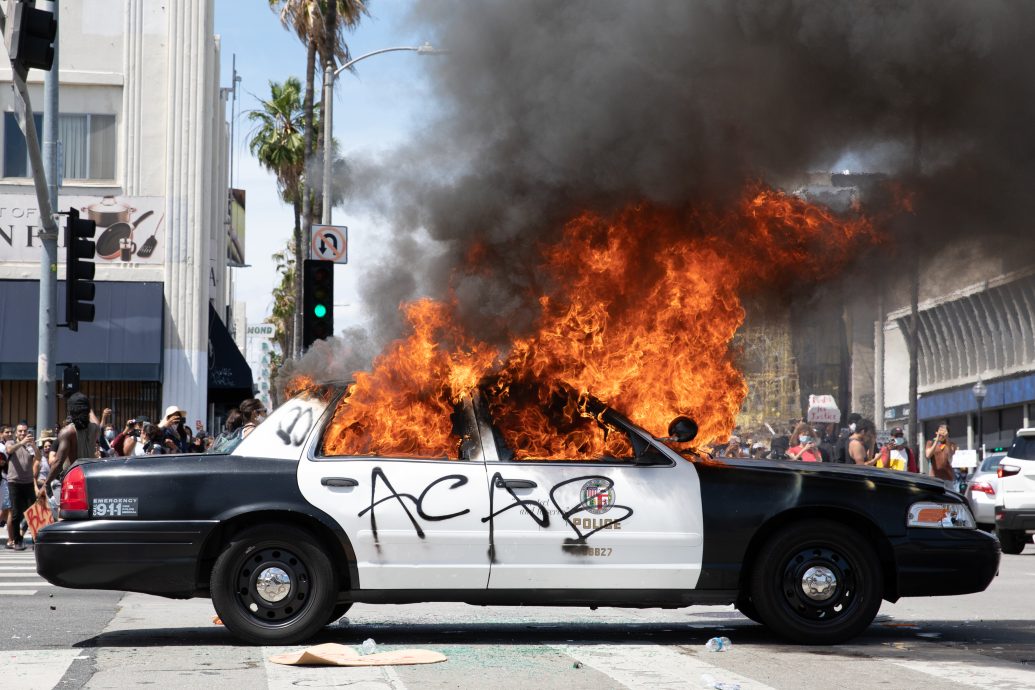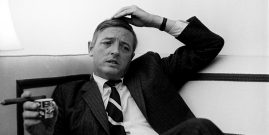Even the errors of anti-liberal Catholics now have rights.
Getting America's Race Riots Wrong
Following the events in Ferguson, Missouri in 2014 and Minneapolis, Minnesota in 2020, the United States experienced mass protests that frequently turned violent. The protests mainly targeted the police, and given the circumstances, one could understand the anger, even if one disagreed with the proposed solutions (such as the defunding of law enforcement). But the violence, which included ferocious attacks on public and private property, seemed to cross a line. Here was pure nihilism: anarchic violence aimed at destruction for its own sake.
How one characterizes such events is important. If they are by and large protests, we should be considering the demands of the marchers. We may not agree with all of them, but perhaps they should be taken seriously. Maybe reforms are needed. If, on the other hand, they are pure acts of indiscriminate violence they should be suppressed—peacefully, if possible, forcefully, if necessary.
Ultimately, it will be the mission of historians to sort out the meanings of these events and our responses to them. They have not done a very good job with previous similar incidents. There are, to my knowledge, no sound comprehensive analyses of African American protests in the late twentieth and early twenty-first centuries. This has left the door open to ideologues like Elizabeth Hinton to fill the gap with a radical, though poorly researched, assessment in her book, America on Fire. One cannot call it revisionist history, however, because there is no history to revise.
The message of Hinton’s book is unambiguous. The black riots of the late 1960s, early 1970s, and the countless disturbances since, including Miami (1980), Los Angeles (1992), and the more recent George Floyd protests, were not riots at all. They were “rebellions”—“political acts in response to an unjust and repressive society.” Hinton tries to prove her case through in-depth discussions of the violence in particular cities—Cairo, Illinois; Alexandria, Virginia; and Cincinnati, Ohio for example. But this strategy is problematic because the causes and events of the many hundreds of disturbances varied from city to city and decade to decade.
In some cases—such as the violence in the wake of the Martin Luther King assassination in April 1968, the 1992 Rodney King beating in Los Angeles, and the George Floyd killing in May 2020—the eruptions were spontaneous expressions of anguish or grief in response to specific events. But most of the black disturbances of the 1960s and afterwards bore no indicia of political motive, and many had no clear cause whatsoever. By all outward signs, they were riots or rampages plain and simple.
Hinton’s research is spotty and selective. She missed published analyses proving empirically that most of the 60s riots had no discernable cause and bore no relation to the degree of black deprivation in terms of employment, family income, or education. For instance, Susan Olzak and Suzanne Shanahan demonstrated that 60 percent of the riots “had no clear-cut target or symbol,” and only 27 percent were in response to some police incident. In his classic study of disorders in 673 cities between 1961 and 1968, Seymour Spilerman found that no deprivation factors were positively or strongly related to the violence.
Hinton blames the police and the War on Crime for instigating what she calls “a cycle of violence” in black communities, but she seems unaware of the massive increase in violent crime in those same communities that prompted the police buildup. She also overlooks or mentions only in passing the enormous toll on black communities of the riot-related looting and arson that drove out stores, decimated property values, and wiped out jobs for decades. By any objective measure, the violence was an utter disaster for African Americans, who made up most of the 228 riot deaths and 12,741 injured.
An Erroneous Timeline
Hinton is also unable to persuasively explain the timing of the late 60s riots or their cessation in the early 1970s. The first major mass violence event, in Watts, Los Angeles, took place just five days after the Voting Rights Act of 1965 became law, an enactment that gave African Americans unprecedented political influence. One year earlier, the National Urban League had rated Los Angeles the best place in the United States for African Americans to reside.
The apogee of the “rebellion” was 1967 through 1969, when, by objective measure, there were 571 mass violence incidents. If these were political revolts the timing certainly was peculiar. African American gains, both economically and in terms of civil rights, had scarcely been equaled in American history. Black family income had doubled since 1940. By 1970, black unemployment had fallen to a mere 4.2 percent and poverty levels had sunk to 34 percent of the population.
The Kennedy and Johnson administrations fully supported civil rights laws and the Civil Rights Act of 1964 dealt a mortal blow to Jim Crow. Congress then passed the Voting Rights Act of 1965, ensuring African American influence in the political system. Johnson also got Congress to adopt his War on Poverty legislation which was intended to primarily benefit low-income African Americans. Not only were the riots anomalous in the face of these advances, they were totally counter-productive as they resulted in the defunding of the anti-poverty policies.
Why, then, would African Americans rebel at this time? There is no obvious explanation. One of Hinton’s rationalizations is that the civil rights era accomplishments “did not fully secure basic needs for most Black people.” In fact, those needs probably were better served in the 1960s than ever before in American history. More likely, the civil rights movement and the promises of civil rights leaders and politicians, including President Johnson, raised expectations of even greater economic gains, advances that realistically require generations to effect.
Hinton also suggests that the War on Crime began in the 1960s and the concomitant law-enforcement buildup helped spur the “rebellion.” Her timeline is way off. The overwhelmed criminal justice system almost collapsed in the late 1960s and early 1970s, and took nearly a decade to be reinvigorated. By the time the system was strengthened, in the mid-to-late 70s, the black riots had already stopped.
Hinton likewise struggles to explain why rioting tailed off and actually ceased altogether in the 1970s, a time of great economic distress for blacks (and whites). If economic conditions trigger riots they surely would have occurred in great numbers from 1973 to 1975, the “stagflation” period and the end of the great postwar economic expansion. Hinton admits that in the 1970s “underlying conditions remained unchanged or worsened.” Odd, then, that the rebellion would end at this time.
Attempts to explain all of these disturbing incidents with a theory of black rebellion simply cannot withstand close scrutiny.
Little Support for Rioting
Hinton assumes, but doesn’t prove, that the disturbances were really politically motivated. Though young radicals, such as the Black Panthers, provided a revolutionary rationale for the violence—a view shared by Hinton—neither the actual behavior of the rioters nor the opinions of ordinary black citizens suggest widespread support for their reasoning.
The most common riot activity was looting. Attacks on political symbols, such as courthouses, statehouses, and even police stations were infrequent. In Detroit, two-thirds of all arrests were for theft. In Newark, more than $8 million in inventory was lost due to looting and damage to stock. A quantitative study of shopkeepers in riot areas found that the rioters were selective, targeting the better quality stores. The quality of the merchandise had more salience in explaining the choice of targets than any other factor, including retaliation for perceived abuse by the merchant, or sheer proximity to the civil disorder. Setting shops ablaze was common during the riots. In 1967 and 1968 alone there were over 10,600 arson incidents. Even black store ownership afforded no protection. Approximately 27 percent of the stores destroyed in Detroit were owned by African Americans.
Among the vast majority of African Americans, the black radicals and their views found little favor. Although roughly three-quarters of blacks polled in a fifteen-city survey approved of Dr. King and the NAACP, only 14 percent supported black radicals H. Rap Brown or Stokely Carmichael. When Carmichael spoke at Detroit’s Cobo Arena one year before the riot, five to six hundred people heard him denounce moderate civil rights groups. Only a month earlier, Dr. King had preached nonviolence in the same twelve-thousand-seat hall to a standing-room-only crowd. When the riots erupted, an estimated 75 percent of U.S. cities had no disorders and 85 percent or more of the black population took no part.
Concededly, post-riot public opinion surveys offer a mixed message. A 1968 poll of more than 5,000 people in fifteen big cities, including 2,800 African Americans, found that 56 percent of black males thought that the disturbances essentially were protests against unfair conditions. Only 9 percent thought they were mainly looting, and 30 percent considered them a 50/50 mix of looting and protest. Strange that Hinton makes no reference to this support for the riots-as-revolts thesis.
But the same survey also found that only 15 percent of black respondents favored violence to gain rights, whereas 39 percent preferred laws and persuasion, and 38 percent, nonviolent protest. Moreover, 90 percent of African Americans did not think that police brutality caused the riots.
Conclusion
Elizabeth Hinton tries to link all of the black-led disturbances from the late 1960s on, right up to the George Floyd protests of 2020-21. “The so-called urban riots from the 1960s to the present,” she claims, “can only be properly understood as rebellions”—revolts against racial injustice.
This has some plausibility given the history of black oppression and the persistent economic gap between blacks and whites. But black conditions improved dramatically in the post-civil rights era, and the details of these myriad violent events varied considerably. Some, like Miami in 1980, began with the fatal police beating of a black businessman; others, like Detroit in 1967, and Watts in 1965, were totally disproportionate responses to utterly routine police activities. Still other disorders, like the Hispanic-dominated riots of the late 1960s, or the overwhelmingly white George Floyd protests, did not involve a majority of African Americans at all.
A more nuanced history of the racial disturbances of the late 1960s and subsequent decades must reflect the actual realities of these disturbing events. Some were protests against brutal police misconduct or other injustices. Some were mainly, as Edward Banfield once put it, “rioting for fun and profit.” And some were little more than lawless rampages. Attempts to explain all of these disturbing incidents with a theory of black rebellion simply cannot withstand close scrutiny.



